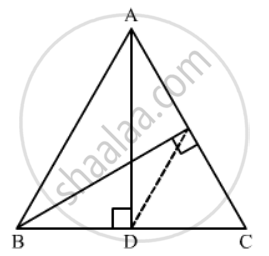Advertisements
Advertisements
प्रश्न
In ∆ABC, AD and BE are altitude. Prove that\[\frac{ar\left( ∆ DEC \right)}{ar\left( ∆ ABC \right)} = \frac{{DC}^2}{{AC}^2}\]
उत्तर
Δ
Given: ΔABC in which AD and BE are altitudes on sides BC and AC respectively.
Since ∠ADB = ∠AEB = 90°, there must be a circle passing through point D and E having AB as diameter.
We also know that, angle in a semi-circle is a right angle.
Now, join DE.
So, ABDE is a cyclic quadrilateral with AB being the diameter of the circle.
∠A + ∠BDE = 180° [Opposite angles in a cyclic quadrilateral are supplementary]
⇒ ∠A + (∠BDA + ∠ADE) = 180°
⇒ ∠BDA + ∠ADE = 180° − ∠A ..... (1)
Again,
∠BDA + ∠ADC = 180° [Linear pair]
⇒ ∠BDA + ∠ADE + ∠EDC = 180°
⇒ ∠BDA + ∠ADE = 180° − ∠EDC ..... (2)
Equating (1) and (2), we get
180° − ∠A = 180° − ∠EDC
⇒ ∠A = ∠EDC
Similarly, ∠B = ∠CED
Now, in ΔABC and ΔDEC, we have
∠A = ∠EDC
∠B = ∠CED
∠C = ∠C
∴ ΔABC ∼ ΔDEC
`⇒ \text{(Area of Δ DEC )}/ \text{(Area of Δ ABC )}= ((DC)/(AC))^2`
APPEARS IN
संबंधित प्रश्न
In below Figure, ΔABC is right angled at C and DE ⊥ AB. Prove that ΔABC ~ ΔADE and Hence find the lengths of AE and DE.

D and E are points on the sides AB and AC respectively of a ΔABC. In each of the following cases, determine whether DE║BC or not.
AB = 11.7cm, AC = 11.2cm, BD = 6.5cm and AE = 4.2cm.
In each of the figures [(i)-(iv)] given below, a line segment is drawn parallel to one side of the triangle and the lengths of certain line-segment are marked. Find the value of x in each of the following :

In ∆ABC, AD is a median. Prove that AB2 + AC2 = 2AD2 + 2DC2.
In the given figure, PQ || BC and AP : PB = 1 : 2. Find\[\frac{area \left( ∆ APQ \right)}{area \left( ∆ ABC \right)}\]

In the given figure, DE || BC in ∆ABC such that BC = 8 cm, AB = 6 cm and DA = 1.5 cm. Find DE.

The areas of two similar triangles are in respectively 9 cm2 and 16 cm2. The ratio of their corresponding sides is ______.
If ∆ABC and ∆DEF are two triangles such tha\[\frac{AB}{DE} = \frac{BC}{EF} = \frac{CA}{FD} = \frac{2}{5}\] , then Area (∆ABC) : Area (∆DEF) =
If ABC is a right triangle right-angled at B and M, N are the mid-points of AB and BC respectively, then 4(AN2 + CM2) =
In a ∆ABC, perpendicular AD from A and BC meets BC at D. If BD = 8 cm, DC = 2 cm and AD = 4 cm, then
